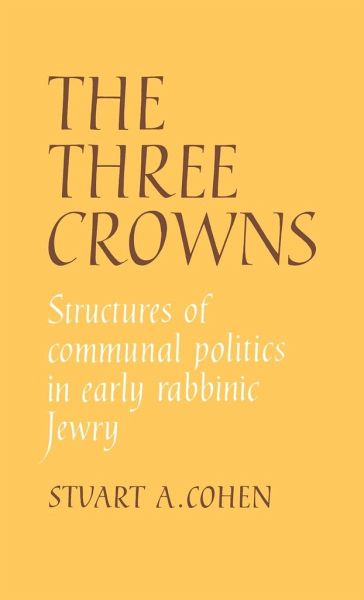
The Three Crowns
Structures of Communal Politics in Early Rabbinic Jewry
Versandkostenfrei!
Versandfertig in 1-2 Wochen
103,99 €
inkl. MwSt.

PAYBACK Punkte
52 °P sammeln!
The Jewish national revival of our times has stimulated scholarly interest in the historical origins and manifestations of Jewry's distinctive traditions of constitutional thought and political action. This study is a contribution to that enquiry. Focusing on the structures of communal rule forged during the first five centuries of the common era, the book presents a novel analysis of the processes whereby the rabbis and their disciples replaced both priests and civic rulers as foci of political royalty and instruments of domestic government throughout the Jewish world. Cohen argues that much ...
The Jewish national revival of our times has stimulated scholarly interest in the historical origins and manifestations of Jewry's distinctive traditions of constitutional thought and political action. This study is a contribution to that enquiry. Focusing on the structures of communal rule forged during the first five centuries of the common era, the book presents a novel analysis of the processes whereby the rabbis and their disciples replaced both priests and civic rulers as foci of political royalty and instruments of domestic government throughout the Jewish world. Cohen argues that much of Jewish political history during the age of the Mishnah and Talmud can be read as a record of the attempt to re-interpret the ancient concept of the three crowns (or clusters of rulership which determined Jewish public behaviour) and adapt it to rabbinic purposes. Drawing on recent scholarship in Hebrew as well as in English, this is the first book to advance a sustained and overtly political analysis of these developments, as opposed to simply a religious one, and its author illuminates throughout the conceptual dimensions which have influenced Jewish institutional practice for much of the past two millenia.
Table of contents:
Introduction; 1. The concept of the three Ketarim; Part 1. Versions of the Past: Visions of the Future: 2. Institutions and their instruments; 3. History as propaganda: the Rabbinic version; 4. Other positions, other priorities; Part II. From Theory to Practice: The Struggle for Supremacy: 5. The first phase (c. 135 bce - c. 100 ce); 6. Rabbis and priests (c. 100 ce - c. 300 ce); 7. Rabbis and appointed rulers (c. 100 ce - c. 400 ce); Part III. Ensuring Hegemony: 8. The institutionalisation of Rabbinic authority; 9. Patterns of succession and pageants of installation; Afterword: a symbol and its resonance; Bibliography, Index.
Table of contents:
Introduction; 1. The concept of the three Ketarim; Part 1. Versions of the Past: Visions of the Future: 2. Institutions and their instruments; 3. History as propaganda: the Rabbinic version; 4. Other positions, other priorities; Part II. From Theory to Practice: The Struggle for Supremacy: 5. The first phase (c. 135 bce - c. 100 ce); 6. Rabbis and priests (c. 100 ce - c. 300 ce); 7. Rabbis and appointed rulers (c. 100 ce - c. 400 ce); Part III. Ensuring Hegemony: 8. The institutionalisation of Rabbinic authority; 9. Patterns of succession and pageants of installation; Afterword: a symbol and its resonance; Bibliography, Index.














